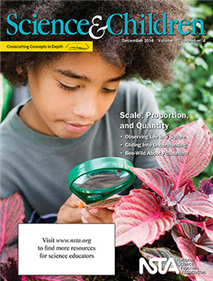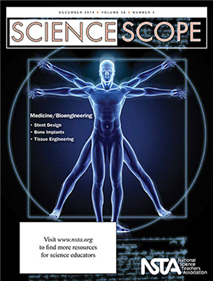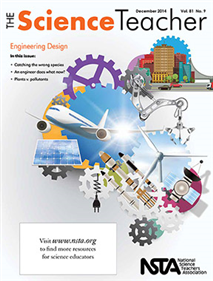All Resources
Journal Article
Cinderella Separates a Mixture
An investigation uses a classic fairy tale to teach students about the properties of substances....
Journal Article
Editor's Note: Scale, Proportion, and Quantity
Science and Children’s editor shares thoughts regarding the current issue....
Journal Article
The Early Years: The Building Blocks of Measurement
This column discusses resources and science topics related to students in grades preK to 2. This month’s issue shares an activity in which students can learn about position, size, and amount....
Journal Article
Formative Assessment Probes: Watermelon and Grape: An Intuitive Rule of Quantity and Proportion
This column focuses on promoting learning through assessment. This month’s issue shows a formative assessment probe that reveals how strong the "More A - More B" intuitive rule is when students are considering the properties of floating and sinking...
Journal Article
Teaching Through Trade Books: Bigger Than a Breadbox?
This column includes activities inspired by children’s literature. This month’s issue offers activities that help students develop their comparison skills and use of measurement units....
Journal Article
Engineering Encounters: Elephant Trunks and Dolphin Tails
An elephant-trunk design challenge introduces students to engineering for animals....
Journal Article
Science 101: Why Do We Need Standard Units?
This column provides background science information for elementary teachers. This month’s issue explains the need for standard units of measure in science....
Journal Article
Methods and Strategies: What's the Big Idea?
This column provides ideas and techniques to enhance your science teaching. This month’s issue discusses three big ideas from the research behind the Next Generation Science Standards....
Journal Article
Engineer a blood-flow pathway and implant a stent in a blocked coronary artery....
Journal Article
Sickle Cell Disease: Relating Community Health and Heredity
Explore cell form and function and genetic inheritance during a study of sickle cell disease....
Journal Article
The Big Break: A Module on Biomedical Engineering Principles and Medical Devices
Investigate bone healing, fractures, and diseases with an activity involving simulated bone and bone implants....
Journal Article
Inspired by Real Science: Biomedical Engineering for Breast Cancer Research in the Classroom
Design a tissue-engineered system using an iterative cycle of development to answer an open-ended question....
Journal Article
Editor's Roundtable: Using Medical Headlines to Meet the NGSS Goals
Science Scope’s editor shares thoughts regarding the current issue....
Journal Article
Guest Editorial: NGSS Case Studies: Economically Disadvantaged Students Developing Conceptual Models
This article focuses on a case study of economically disadvantaged students, which can serve as a vehicle for professional development activities as teachers examine the case studies and use them as prototypes for applying three-dimensional learning ...
Journal Article
Everyday Engineering: If It's Engineered, Is It Wood?
This article describes a 5E learning cycle lesson in which students explore one aspect of manufactured wood, namely, strength....
Journal Article
Tried and True: Building Bridges With the NGSS
This column provides classic demonstrations and experiments with a new twist. This month’s issue describes an engaging and challenging series of lessons and activities in which students develop an appreciation for the conception, design, engineerin...
Journal Article
Teacher's Toolkit: A Scaffolding Suite to Support Evidence-Based Modeling and Argumentation
This column provides how-to strategies and practical advice for the science teacher. This month’s issue presents an effective and flexible suite of scaffolds to foster student growth in scientific reasoning and content knowledge in the context of s...
Journal Article
Scope on the Skies: Not Too Hot, Not Too Cold
This column focuses on astronomy throughout the year. This month’s issue discusses the search for exoplanets that are Earthlike in both location relative to their host star and the physical properties of the planets based on their location....
Journal Article
Scope on Safety: Tooling Up for Safer STEM Activities
This column shares safety information for your classroom. This month’s issue discusses the safety of using hand and power tools when conducting hands-on STEM experiences....
Journal Article
Engineering a solution to the problem of bycatch in the tuna fishery....
Journal Article
Building a voltaic cell in the high school chemistry classroom....
Journal Article
A 5E learning activity that compares engineering to science....
Journal Article
Bringing engineering design practices and real-world context to the science classroom....
Journal Article
Strategies to overcome anxieties about adding engineering to your curriculum....
Journal Article
Editor's Corner: Engineering a New World
The Science Teacher’s editor shares thoughts on the current issue....
Journal Article
Science 2.0: Protecting Students' Online Privacy—By Law
This column shares web tools that support learning. This month’s issue talks about students' digital footprint and making sure that students understand and appreciate privacy and the value of their personal information....
Journal Article
The Green Room: Renewable Energy
This column focuses on making your teaching more environmentally friendly. This month’s issue discusses activities to help students learn about renewable energy....
Journal Article
The New Teacher's Toolbox: Parting Tips for Your Toolbox
This column shares tips for teachers just beginning their career. This month’s issue is the final column for The New Teacher's Toolbox. Michael Romano shares realizations he's had during his journey that might offer needed perspective for those fir...
Journal Article
Health Wise: The Scientific Case for Starting High School Later
This Q&A style column provides up-to-date information on current health topics—helping students (and teachers) make healthy choices. This month’s issue discusses changes in the brain during adolescence that alter teens' circadian rhythm....
Journal Article
Safer Science: Beware of the Rainbow
This column provides best safety practices for the science classroom and laboratory. This month’s issue covers the basic safety measures that should be used for all laboratory activities and demonstrations....
Journal Article
Career of the Month: Biomedical Engineer
This column shares interviews with professionals using science in the workplace. This month’s issue describes Paul DeVasConCellos's career path to becoming a biomedical engineer....





